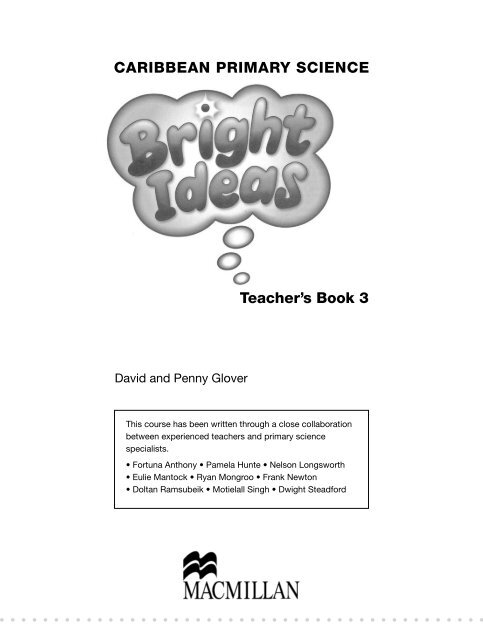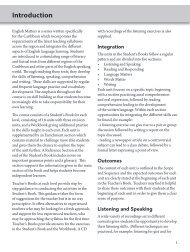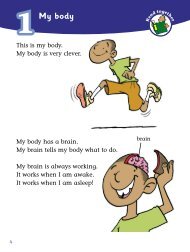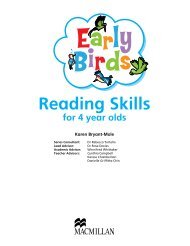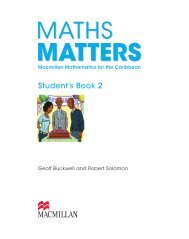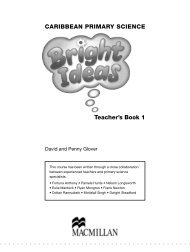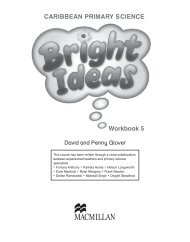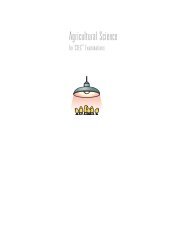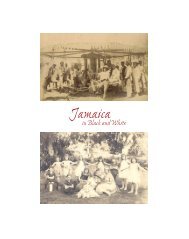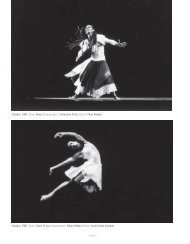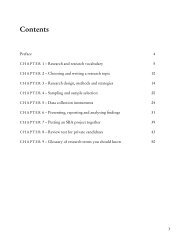CARIBBEAN PRIMARY SCIENCE Teacher's Book 3 - Macmillan ...
CARIBBEAN PRIMARY SCIENCE Teacher's Book 3 - Macmillan ...
CARIBBEAN PRIMARY SCIENCE Teacher's Book 3 - Macmillan ...
- No tags were found...
Create successful ePaper yourself
Turn your PDF publications into a flip-book with our unique Google optimized e-Paper software.
<strong>CARIBBEAN</strong> <strong>PRIMARY</strong> <strong>SCIENCE</strong>Teacher’s <strong>Book</strong> 3David and Penny GloverThis course has been written through a close collaborationbetween experienced teachers and primary sciencespecialists.• Fortuna Anthony • Pamela Hunte • Nelson Longsworth• Eulie Mantock • Ryan Mongroo • Frank Newton• Doltan Ramsubeik • Motielall Singh • Dwight Steadford<strong>Book</strong> 1.indb 112/21/10 11:47:38 AM
ContentsIntroduction 5What is science? 5Why teach science in the primary school? 6The primary science curriculum 7Using Bright Ideas with your curriculum 8Lesson planning 9Resources for science teaching 12<strong>Book</strong>s, songs, poetry, raps and rhymes 15Field work and visits 15Displays 17Assessing children’s progress in science 17Developing children’s scientific vocabulary 18Developing science process skills 18Science process skills in Bright Ideas 24Safety 25Lesson plans 28Unit 1 My body 28Unit 2 Living things 41Unit 3 The environment 54Unit 4 Matter and materials 71Unit 5 Structures and machines 84Unit 6 Energy and space 92ResourcesBright Ideas Student’s <strong>Book</strong> 3 Examination practice answers 103Bright Ideas Workbook 3 answers 104Riddles and rhymes for Year 3 Science 112Planning grids 115Bright Ideas Year 3 Scope and sequence 118<strong>Book</strong> 1.indb 312/21/10 11:47:38 AM
Series preface – Bright IdeasThe Bright Ideas series is a comprehensive science course for all students in primary schools.Building on practical experience and investigation, the books follow current best practice inscience education. Through engaging content and carefully graded activities and exercises,students are guided to develop a sound framework of scientific knowledge, understanding andskills. There are seven full-colour Student’s <strong>Book</strong>s from kindergarten level to the final year ofprimary school. Each Student’s <strong>Book</strong> is accompanied by a Workbook.This Teacher’s <strong>Book</strong> provides detailed support for teachers using the Year 3 Student’s <strong>Book</strong> as thebasis for their science teaching through the school year. The introduction starts with a discussionof the question ‘What is science?’ and sets out the case for teaching investigative science in theprimary school. Subsequent sections deal in turn with the primary science curriculum; matchingthe content of Bright Ideas to your curriculum; lesson planning and preparation; resources forscience teaching; field work and visits; displays; assessment; developing science process skills;and safety in science teaching.Pages 28–103 of the guide present sample lesson plans for each of the 50 lessons in theStudent’s <strong>Book</strong>s. Each lesson plan lists the lesson objectives and the resources required. Thereare ideas for starter activities and lesson development and suggestions for summarising andevaluating the lesson. There are also suggestions for extension activities, cross-curriculum linksand answers to the Student’s <strong>Book</strong> questions.On pages 115–117 you will find printable grids and planning forms to assist your planning andrecord keeping.Science teaching, especially when it is ‘hands-on’, can be highly enjoyable and rewarding forteachers and students alike. We hope that the Bright Ideas course will contribute both to theeffectiveness of your teaching and to the pleasure that you and your class gain from studyingscience.David and Penny Glover<strong>Book</strong> 1.indb 412/21/10 11:47:39 AM
I N T R O D U C T I O NWhy teach science in the primary school?A generation ago science was not commonly taught as a separate subject in primary schools.At best, there would be some nature study and a few model-making activities – which mightexpose children to some simple applications of science in technology – but investigations andexperiments were not on the menu until secondary school and, even then, the emphasis wasoften more on learning about science, rather than learning to do science.With the move away from the didactic ‘chalk-and-talk’ approach to education, towards a more childcentredmodel of learning that took place from the 1960s onwards, science gradually took its placein the primary curriculum. Experiments with discovery learning and new educational theories, whichemphasised the importance of children ‘constructing’ their own understanding through first-handexperiences and by sharing their ideas with others, developed in parallel with the growing influenceof science and technology in society. As politicians recognised the importance of science educationfor economies and society in general, educators discovered the value of the hands-on approach toscience in motivating and enhancing children’s intellectual development in the primary school.Investigative science motivates and promotes real learningToday, the case for teaching primary science hardly needs to be stated. Science, alongsidenumeracy and literacy, is a core component of the primary school curriculum in schools aroundthe world. The reasons for teaching science at the primary level may be summarised as follows:● investigation-based science learning develops children’s curiosity, problem-solving, practicaland communication skills● basic scientific knowledge of the human body, diet, living things, the environment, materials,forces and energy contributes to children’s developing awareness of themselves and theirrelationship to their surroundings; this knowledge will help them to make healthy choices, tokeep safe and to solve problems as they move through life● scientific values and attitudes such as respect for evidence, questioning, flexible thinking andthe willingness to share knowledge and ideas are relevant in all areas of children’s learning, notjust science● through science, children become aware of environmental issues and the impact that theyas individuals can have on their surroundings; they develop respect for living things and theirenvironment and become aware of the harm that simple actions such as littering, wastingenergy or contaminating water supplies can cause● in the majority of countries science is an examination subject at the end of the final year ofprimary school. Children may need to perform well in science to gain a place at the secondaryschool of their choice<strong>Book</strong> 1.indb 612/21/10 11:47:40 AM
I N T R O D U C T I O N● a good knowledge of science gained in the primary school prepares children to do well in theirmore formal science education at secondary school. Good results in secondary school scienceexaminations open up a wide range of career opportunities.The primary science curriculumA preliminary reading of primary science curriculum documents from the countries of theCaribbean Region and beyond suggests that each is highly individual, with less in commonbetween the specifications from different countries than for, say, numeracy and literacy.However, a more thorough analysis shows that, although different topics may be tackled indifferent years and there are some country-specific contexts and examples through whichscience is taught, the majority of themes are common to all primary science syllabus documents.Table 1 identifies the core science themes that almost invariably appear at different points in thekindergarten and the six years of primary school.Table 1 Themes common to the majority of primary science syllabusesTheme 1How science worksTheme 2The human bodyTheme 3Plants and animalsTheme 4The environmentTheme 5The Earth and its featuresTheme 6Materials and theirpropertiesTheme 7Forces and energyTheme 8SpaceScientific enquiry and investigation skills: observing, questioning, classifying,measuring, planning; hypothesising, evaluation, concluding, etc.Body parts and processes: senses and sense organs, health and hygiene,growth, reproduction, organs and organ systems, digestion, nutrition,disease, healthy lifestyles, etc.Living things: classification, variety, body parts and systems, life processes,interactions, life cycles, photosynthesis, useful plants and animals, caring foranimals, gardening, etc.Habitats and ecosystems: interdependence, different ecosystems, threatsto the environment, pollution, deforestation, global warming, endangeredspecies, sustainable development, etc.The structure and components of the Earth: characteristics of rocks and soil,rock and soil formation, minerals and their uses, landforms, the atmosphere,weather conditions, climate, water supply, the water cycle, natural disasters,etc.Properties and uses of materials: wood, plastic, metal, glass, etc., matchingmaterials to their applications, conductors and insulators, shaping materials,using tools, natural and synthetic materials, simple structures, etc.Force, energy and movement: the effects of forces, types of force, friction,gravity, simple machines, energy types and sources, fossil fuels and globalwarming, alternative energy sources, the characteristics and uses of heat,light and sound, sources and uses of electricity, simple circuits, magnetismand its applications, etc.The Earth in space: the Earth, the Sun and the Moon, day and night, theseasons, the tides, the phases of the Moon, eclipses, the Solar System,characteristics of the planets, space travel, stars and galaxies, the Universe,etc.In practice, each theme is revisited several times as children progress through the school. Topicsfrom a given theme, the human body, for example, are taught in different year groups – both as thesyllabus demands and as the children become ready to deal with the topic at the depth required.The main external parts of the human body will probably be introduced in the kindergarten, but theinternal organs and their detailed functions will probably not be covered until Years 5 or 6. Childrenprogress at different rates and so the opportunity to revisit a topic gives the chance to reinforceand develop understanding; a topic which had been only partly understood in an earlier year maybe grasped more fully when it is met again and taken further in later years.<strong>Book</strong> 1.indb 712/21/10 11:47:41 AM
I N T R O D U C T I O Nplants Y6 animals human energy body: spacematerials Earth digestive ecosystemsmagnetism Y5 electricity plantsanimals energy human space body: forcematerials Earth ecosystemsY4internal organsmagnetism electricity plantsanimals energy human space body: forcematerials Y3 Earth diet and ecosystems healthmagnetism electricity plantsanimals Y2 energy human space body: forcematerials Earth growth ecosystemsmagnetism Y1 electricity plantsanimals energy human space body: forcematerials Earth ecosystemsKexternal partsThe spiral curriculum. Progression through the primaryscience curriculum is more akin to a spiral than a straight line.Children revisit ideas and take them to a higher level as theyprogress up the learning spiral.Themes 2–8 in Table 1 are the knowledge-based areas of the curriculum – the traditional ‘content’of science. As children work on these themes they learn the basic facts of science – facts aboutliving things, materials, energy, the planets and so on, but they should not be passive absorbers offacts. Learning is more effective when learners are actively engaged with the topic: planning andcarrying out investigations, participating in discussions, using the library or the internet to conductresearch for a poster or a display. It is Theme 1 ‘How science works’ that is concerned with theprocesses, skills and attitudes of science. As children put these skills into practice, they becomescientists themselves and the syllabus content is brought to life.In some syllabus documents, science skills are listed in the overall aims of the course; in others theymay be set out as a separate set of objectives in a section similar to the objectives for the knowledgebasedthemes. Wherever they appear in the syllabus, it is important we recognise that science skillscannot be taught in isolation, but should be introduced in real contexts. The idea of a ‘fair test’, forexample, might be introduced when children compare the conditions in which seeds germinate in Years1 or 2. The concept of fairness can then become part of investigations in all parts of the curriculum.Using Bright Ideas with your curriculumThe Bright Ideas course has been written for use throughout the Caribbean Region. In developingthe course, syllabus documents from around the region were examined to select the topics forinclusion. Our aim has been to produce a comprehensive course which includes all the topics ateach level that teachers will need to satisfy their syllabus requirements. This means that:● each Student’s <strong>Book</strong> contains more material than will be required for any one syllabus● teachers must select the material they need for their syllabus● ‘extra’ material is available in each book for extension and enrichment.The Student’s <strong>Book</strong>s have been structured to make the selection task as straightforward aspossible. The content has been carefully broken down into self-contained two or three page‘lessons’. The lessons are grouped as subject Units.Each lesson includes the following elements:● list of lesson objectives● main content illustrated with artwork and/or photographs<strong>Book</strong> 1.indb 812/21/10 11:47:42 AM
I N T R O D U C T I O N● one or more activities (these are a mixture of experiments, group work and pencil-and-paperactivities)● often a fascinating fact box● key words● a copy-and-complete summary of key learning points● one or two review questions.The learning objectives for each lesson are clearly stated in the Student’s <strong>Book</strong>s in the boxfollowing the lesson title. For example, for Unit 1, Lesson 1, of Year 3:Eyes are for seeingOBJECTIVESWhen you have completed this lesson you will be able to:● describe the main external parts of the eye● describe the changes that take place to the eye in dim and bright lightThe knowledge and skills areas supported by the lesson are summarised in the scope andsequence table at the back of the Student’s <strong>Book</strong> and Teacher’s <strong>Book</strong>. For example:Lesson Title Science Knowledge Science SkillsUNIT 1 MY BODYEyes are for seeingThe external parts of the eyeHow the eye responds to dim andbright lightobserving; sketching andlabelling diagramsTo assist your planning, all this information is brought together as a series of printable planninggrids at the back of this guide. You can use copies of the planning grids together with yoursyllabus document to identify those lessons you will be teaching through the school year. Use theblank columns in the grids to add additional comments and information as required.Lesson planningThe Student’s <strong>Book</strong> provides the basis for individual lessons, with the core content, activities andquestions to reinforce and review the students’ learning. Occasionally you may wish to base anentire lesson around book-work, but science lessons would be dull and repetitive if they wereall taught ‘by-the-book’. In general, lessons should be individually planned, with a variety ofresources used alongside the book. At various stages of the lesson, students may be engaged indiscussion with each other and/or the teacher, question-and-answer, practical work, observingdemonstrations, drawing or note making, answering written questions, reciting poems andrhymes, singing and other activities (though not necessarily all of the above in any one lesson!)The key to a good lesson is good planning. The form below is an outline lesson plan for a sciencelesson. The sections have been completed with explanations of the kinds of activities the teacherand the children should be engaged in at different points in the lesson. A blank lesson plan form isavailable on page 115 for you to photocopy. Pages 28–103 of this Teacher’s <strong>Book</strong> present samplelesson plans for each of the topics in the Year 3 Student’s <strong>Book</strong>.<strong>Book</strong> 1.indb 912/21/10 11:47:43 AM
I N T R O D U C T I O NOutline science lesson planSubject: Science Year 3Theme: The lesson theme; for example, My bodyDate: The date taughtTitle: The specific lesson title; for example, Eyes are for seeingSyllabus objectives: The syllabus objective(s) the lesson is planned to cover; for example,‘When the student has completed this lesson he or she will be able to: describe the main externalparts of the eye; describe the changes that take place to the eye in dim and bright light’Knowledge and skills: The science knowledge and skills the lesson develops; for example,the external parts of the eye; how the eye responds to dim and bright light; observing;sketching and labelling diagramsResources: Resources required to teach the lesson, which should be prepared in advance;for example, a set of Student’s <strong>Book</strong>s; science notebooks; mirrors (use small safety mirrors;do not use large glass mirrors which could break if dropped); pencils and paper; a poster orlarge model showing the structure of the human eyeLesson introductionThis is the first part of the lesson in which the teacher revises previous work and introducesthe new topic. It is important to engage the children’s interest and imagination at the outsetof the lesson. Discussion of specimens and/or the children’s own experiences and existingknowledge is a good way to do this. For example, the teacher could use a plastic model or alarge diagram of the eye to stimulate a discussion of how we see to read our science books.Lesson developmentThis is the main part of the lesson in which the students are engaged in activities andinvestigations. For example, children work in pairs with mirrors to observe and draw theirown and their partner’s eyes.Evaluation and summaryIn this part of the lesson the students report their ideas, observations and conclusions, andthe teacher helps them to state the results by introducing appropriate new vocabulary. Theteacher summarises the lesson content, for example by drawing sketches or writing newvocabulary on the board. The ‘What you have learnt’ and ‘Check your progress’ questions inthe Student’s <strong>Book</strong> could be used at this stage. The teacher may conclude the lesson with anactivity or questions that reinforce the key objectives; for example by teaching the children asong or poem about the topic (see the poem ‘Eyesight’ on page 112 of this guide) .Extension and linksThis part of the lesson plan provides suggestions for additional activities to use when time permitsto extend and enrich the students’ learning. Links are made to other areas of the curriculum.What you have learntAnswers are given for the Student’s <strong>Book</strong> questions.Check your progress answersAnswers are given for the Student’s <strong>Book</strong> questions.1 0<strong>Book</strong> 1.indb 1012/21/10 11:47:43 AM


